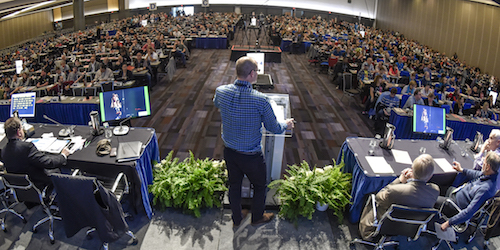The IBEW has a powerful new advocate on the British Columbia Federation of Labour. First District International Representative Laird Cronk was elected president of the organization on Nov. 29.

|
| First District International Representative Laird Cronk, the newly elected president of the British Columbia Federation of Labour, addresses the federation’s recent convention in Vancouver.
|
“Having served at the district level for the last 18 years, Laird is a great choice to represent our union and all of B.C.’s building trades before the federation,” IBEW International President Lonnie Stephenson said. “I hope all electrical workers will give him their full support as he takes on this new role.”
Cronk and his running mate, B.C. Government and Service Employees Union Executive Vice President Sussanne Skidmore, were elected president and secretary-treasurer, respectively, by acclamation of the convention’s 2,000 delegates at the federation’s 58th biennial convention, which took place in Vancouver from Nov. 26-30.
“We are stronger and better as a labour movement when we work together,” Cronk told convention delegates in his acceptance speech. “When we’re together — and we seem to be together today — there’s nothing we can’t achieve.”
Irene Lanzinger, the federation’s outgoing president, announced she would not seek another term as the group’s leader, leaving the door open for Cronk, a longtime member of Vancouver Island, B.C., Local 230, to toss his hat into the ring.
“I decided to run for president because I believe I have the skills, the experience and the passion to build on our strong foundation by working to make the labour movement even more central to the lives of workers in this province,” he said.
Convention delegates are permitted to nominate candidates up until elections are set to begin. In the runup to the election, the federation’s executive officers, made up of representatives from its 15 largest unions, had worked on gaining member unions’ support for the Cronk/Skidmore slate.
Cronk credited the board’s efforts, coupled with overwhelming and diverse grassroots support for the slate, for helping to propel the pair to a two-year term as leaders of the federation, which represents nearly half a million members of more than 50 affiliated unions across the province.
“Even though the federation is in a similar universe to the IBEW’s, this will be a significant change from what I’m used to,” Cronk said. “When you’re the president of a province’s labour federation, you become a very public figure.”
In addition to his role as a First District international representative, Cronk also serves on the board of directors of the province’s Industry Training Authority.
“I’m very proud of Laird and his campaign,” said First District Vice President Tom Reid. “B.C.’s federation has a long history of fighting for the rights of all working people, and the province’s labour movement will be in good hands under his leadership.”
Since 2012, Cronk has represented the union as a vice president on the federation’s executive council, and he has chaired its apprenticeship and skilled trades working group for the past four years.
Among the large unions that publicly endorsed the Cronk/Skidmore slate were the United Steel Workers, the Canadian Union of Public Employees—British Columbia, Unite Here, and United Food and Commercial Workers, as well as the IBEW’s British Columbia Provincial Council.
“I have known Brother Cronk on a professional level for the better part of 35 years, and I feel confident in saying he has always put the betterment of the labour movement in B.C. in front of every decision he’s made,” said Phil Venoit, the council’s chairman and business manager of Victoria, B.C., Local 230.
Cronk assumes his new role at the same time that several major infrastructure projects are underway in his province, including a $650 million project to widen a long stretch of the Trans-Canada Highway and a $1.4 billion project to replace the Fraser River’s aging Pattullo Bridge.
The new president also is mindful that there are several in-progress environmentally-sensitive projects for which some unions in the federation have valid reasons not to fully support, such as the massive Site C Dam project on the Peace River in northeast B.C., the LNG Canada natural gas liquefaction project site at Kitimat, and the Trans Mountain pipeline connecting Alberta’s oil sands with Vancouver Harbour, which over the summer was nationalized by Canada’s federal government.
“The pipeline expansion project remains complicated, but if it’s going to be built with federal funding, having it safely built by skilled, unionized tradespeople should help dispel many of the concerns surrounding it,” Cronk said.
One thing that should help move such projects along is the province-wide “community benefits” project labour agreement, announced in July by British Columbia Premier John Horgan, that is designed to prioritize local labour, sustaining wages, and safety on public infrastructure projects.
Such agreements, promised by Horgan’s New Democratic Party government during the 2017 provincial election campaign, were key to securing the support of IBEW and some other building trades during that campaign.
“After 16 years of systematic attacks from the former B.C. Liberal government, the fact that the labour movement is still alive-and-kicking is amazing, and now we have the political and economic conditions to build an even stronger movement,” said Cronk.
Going forward, Cronk also would like to see more workers in the province represented by unions, telling the Star Vancouver that those in so-called “gig economy” jobs or other marginalized workers deserve a chance to bargain collectively for better working conditions and pay.
“The anti-union crowd don’t want you to know it, but the history is clear — the more union members there are, the better the economy works for everyone,” he said. “We’re ready to get to work and build an even stronger, more effective labour movement for all working people.”